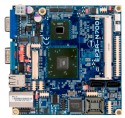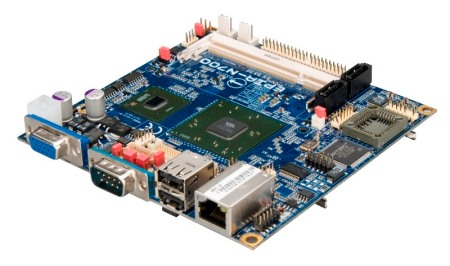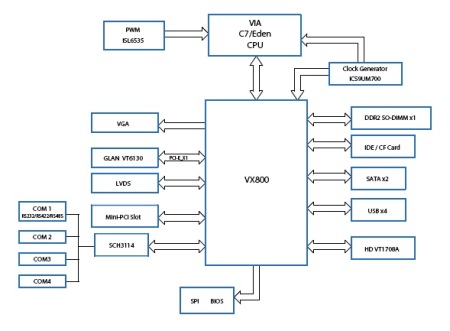Via announces “lowest-profile” nano-ITX board
Aug 15, 2008 — by Eric Brown — from the LinuxDevices Archive — 2 views Via Technologies announced a nano-ITX board targeting compact industrial PCs and embedded automation. The Epia N700 includes Via's 1.5GHz C7 or 500MHz Eden ULV processors, gigabit Ethernet, two SATA ports, four USB ports, four COM ports, plus Compact Flash and Mini PCI expansion, the company says.
Via Technologies announced a nano-ITX board targeting compact industrial PCs and embedded automation. The Epia N700 includes Via's 1.5GHz C7 or 500MHz Eden ULV processors, gigabit Ethernet, two SATA ports, four USB ports, four COM ports, plus Compact Flash and Mini PCI expansion, the company says.
(Click here for a larger view of Via's Epia N700)
Via touts the Epia N700 as the “lowest-profile nano-ITX board ever.” The highly integrated device is also said to be the first nano-ITX board to use Via's VX800, a 33 x 33mm chip that integrates northbridge and southbridge functionality.

Via's Epia N700
(Click to enlarge)
The VX800 — visible at the center of the Epia N700 photo above — supports gigabit Ethernet and includes Via's Chrome9 2D/3D graphics engine with DirectX 9 compatibility and hardware rotation capability. It provides the Epia N700 with hardware acceleration of MPEG-2, MPEG-4, VC1 and DiVX video formats. For more details on the VX800 and its smaller, mobile-oriented relative, the VX800U, see our earlier coverage, here.

A block diagram of Via's Epia N700
(Click to enlarge)
The Epia N700 is available with a choice of Via processors, either the 1.5GHz C7, or the 500MHz Eden ULV. The latter CPU has a maximum TDP of one Watt, which, combined with the VX800's five-Watt TDP max, lets the Epia N700 use as little as six Watts, according to Via. Maximum memory capacity of the board, meanwhile, is 2GB of 533/667MHz DDR2 RAM.

The Epia N700's “real-world” connectors
Like many devices of its type, the Epia N700 offers a combination of real-world connectors on the edge of the board, plus other interfaces served up via pin headers. The photo above illustrates the N700's edge-mounted VGA, serial, RJ45, and dual USB connectors, while also providing an indication of just how compact the 4.7 x 4.7-inch board is.
Other interfaces, provided via pin headers, include two additional USB ports, three more serial ports, keyboard/mouse and audio connectors, and an LVDS connector. The Epia N700 also has two SATA ports, plus an IDE interface that's said to double as a Compact Flash connector.
On the back of the board, hence not shown in our photographs, is a Mini PCI slot. Wireless networking is an optional feature that can be added either via Mini PCI or USB, according to Via.
Features and specifications listed by Via for the Epia N700 include:
- Processor — 1.5GHz Via C7 or 500MHz Via Eden ULV
- Memory — up to 2GB of DDR2 memory via single SODIMM slot
- Display — Integrated VIA Chrome9 HC3 DX9 3D/2D graphics with MPEG-2/4, WMV9 decoding acceleration
- Networking — gigabit Ethernet with RJ45 connector
- Other I/O:
- 4 x serial (1 x RS232/422/485 on board's edge; 3 x RS232 via pin headers)
- 4 x USB (2 on board edge, 2 via headers)
- 1 x VGA (on edge)
- 1 x LVDS (via header)
- 1 x IDE/Compact Flash connector
- audio pin header
- keyboard/mouse pin header
- 1 x digital I/O pin header (4 x GPI and 4 x GPIO)
- 1 x SMbus pin header
- 2 x SATA
- 4 x serial (1 x RS232/422/485 on board's edge; 3 x RS232 via pin headers)
- Expansion — Mini PCI slot
- Operating temperature — 0 to 60 deg. C
- Dimensions — 4.7 x 4.7 inches
According to Via, the Epia N700 is compatible with Linux, Windows XP Embedded, Windows CE, and Windows XP. Pricing was not released, but the board is sampling now and should be available from distributors by the middle of September, according to the company.
Further information may be available from Via's website, here.
This article was originally published on LinuxDevices.com and has been donated to the open source community by QuinStreet Inc. Please visit LinuxToday.com for up-to-date news and articles about Linux and open source.